Home / Intramolecular Friedel-Crafts Reactions
Reactions of Aromatic Molecules
Intramolecular Friedel-Crafts Reactions
Last updated: October 7th, 2022 |
The Intramolecular Friedel-Crafts Reaction
We explore the intramolecular Friedel-Crafts reaction in this post. But first, a very quick refresher on intramolecular reactions in general.
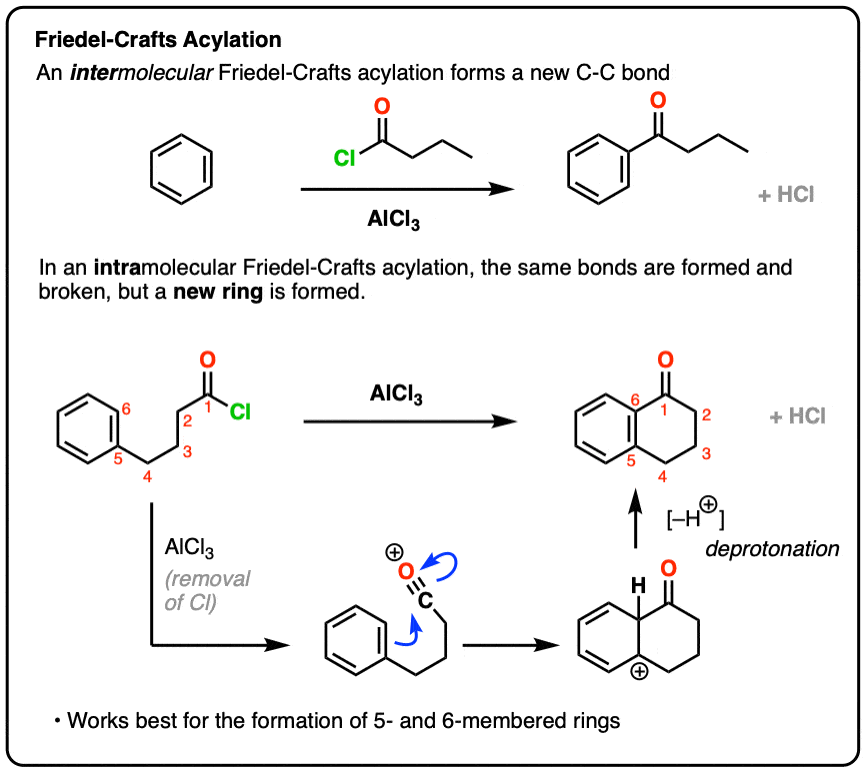
Table of Contents
- Quick Recap: Intramolecular Reactions Can Be Tricky
- Intramolecular Friedel-Crafts Alkylation
- Intramolecular Friedel-Crafts Acylation
- Summary: Intramolecular Friedel-Crafts Reactions
- Notes
- (Advanced) References and Further Reading
1. Quick Recap: Intramolecular Reactions Can Be Tricky
Here is an instant formula for an organic chemistry exam question.
Start with a straightforward reaction that students understand fairly well, like the Williamson Ether synthesis….
(drawn weirdly, for a good purpose)
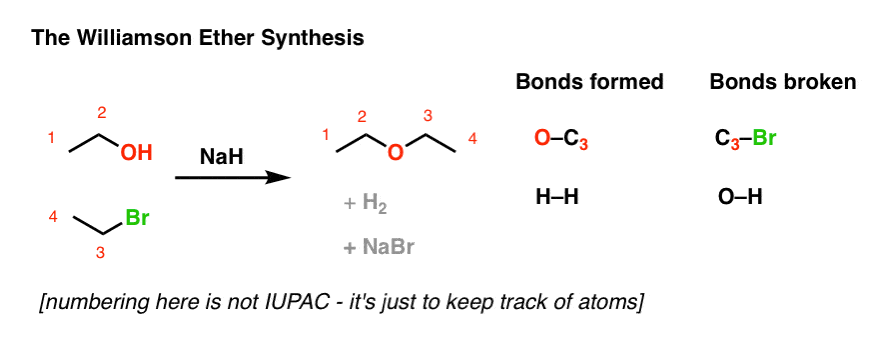
…now, just make a simple modification by adding one bond. Voila. Instant stumper!

The second question above is an example of an intramolecular reaction, where the nucleophile and electrophile are on the same molecule, and the result of their reaction is that a ring is formed. In past posts on this subject, I’ve used the analogy of a belt. It still works.
Why are intramolecular reactions good exam questions? Because they sort out the students who learn the reactions by memorizing a table of simple examples, and those who actually know (and most importantly, can apply!) the pattern of bonds formed and bonds broken. Furthermore, it involves no new concepts, which makes it totally fair game.
Intramolecular variants exist for a lot of different reactions, and it comes up so often that it’s worth mentioning separately. The Friedel-Crafts alkylation and Friedel-Crafts acylation reactions are no exception.
2. Intramolecular Friedel-Crafts Alkylation
Here’s an example of an intermolecular Friedel-Crafts alkylation. The nucleophile is the aromatic ring, and the electrophile is the alkyl chloride. Add a little catalyst (AlCl3) and boom! electrophilic aromatic substitution.

Now let’s change things up just a little bit. We’ll attach the alkyl halide to the ring via a new carbon-carbon bond, and then add the catalyst. What’s the product?
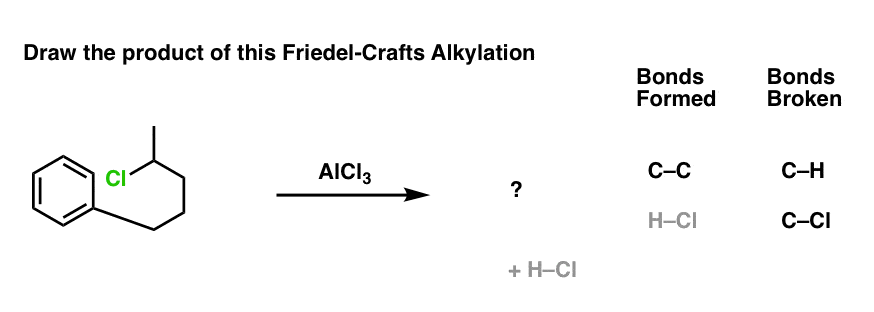
No new concepts! Same pattern of bonds that form and break. But if you haven’t seen an example like this before, it might throw you completely off your memorized notes. That’s the plan! [Cue recording of “evil laugh”].
OK. Here’s the mechanism, and the final product is drawn out below left.
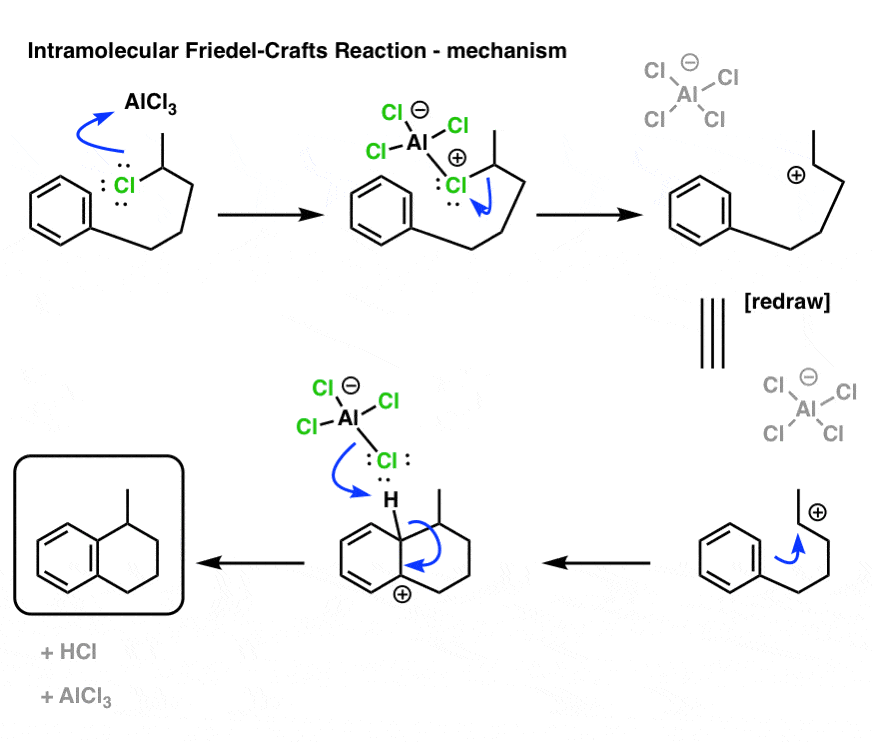
I want you to note that the overall pattern of bonds that form and bonds that break is exactly the same in the intramolecular case as it is in the intermolecular case, namely: form C-C and H-Cl, break C-H and C-Cl.
Timeless advice for drawing out the mechanism for a reaction like this:
- number the carbons! it’s really easy “drop” a carbon in your drawings, and that will lose you points.
- draw the “ugly version” first, and THEN re-draw to make it look nice. Don’t worry about making it look pretty until you have drawn in the bonds that form and break.
In the case of the Friedel-Crafts, the intramolecular version works best for making 6-membered rings, but it’s also possible to use the Friedel-Crafts to make 5- and 7- membered rings as well (not shown).
Here’s a slightly more advanced practice problem that starts with benzene. Can you draw the final product? (answer below)
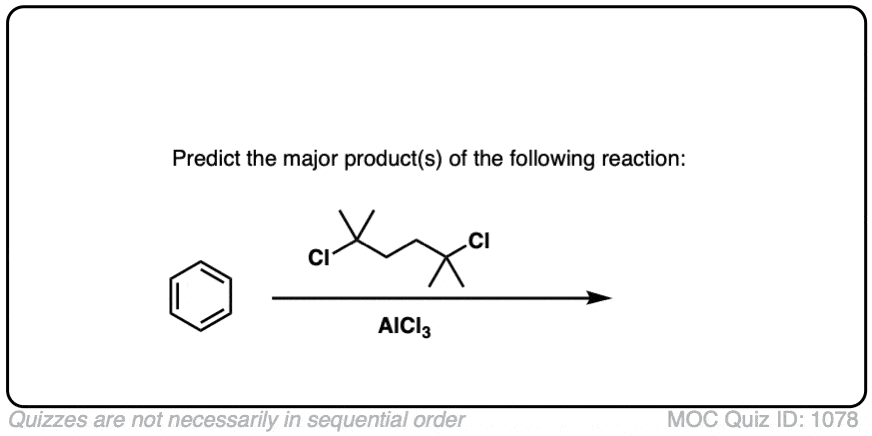 Click to Flip
Click to Flip
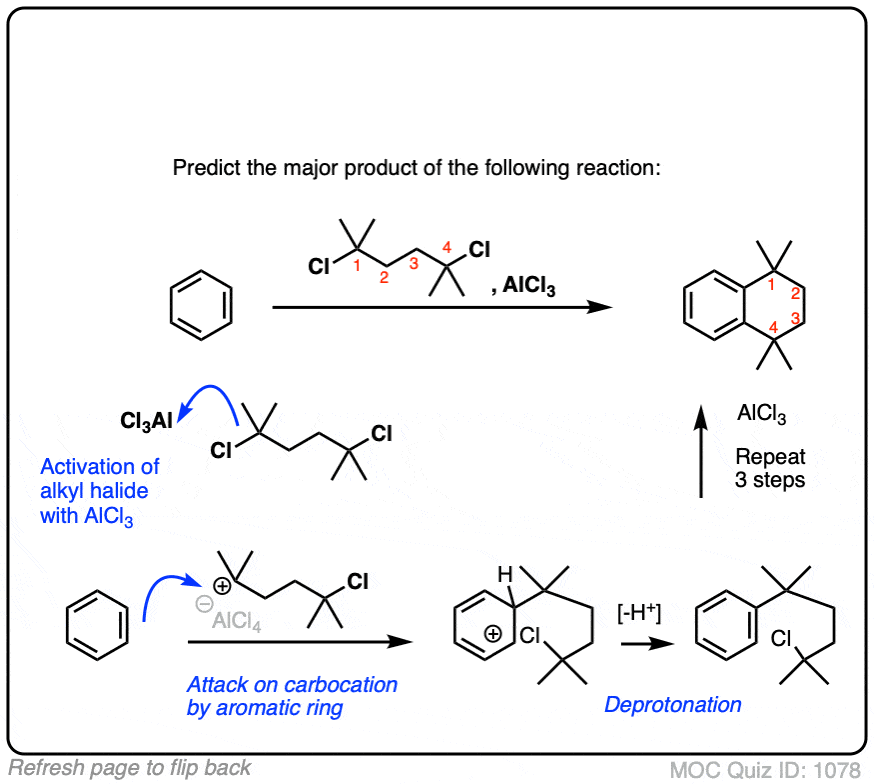
3. Intramolecular Friedel-Crafts Acylation
Once you’ve seen the intramolecular Friedel-Crafts alkylation, the intramolecular Friedel-Crafts acylation is not exactly going to come as a surprise.
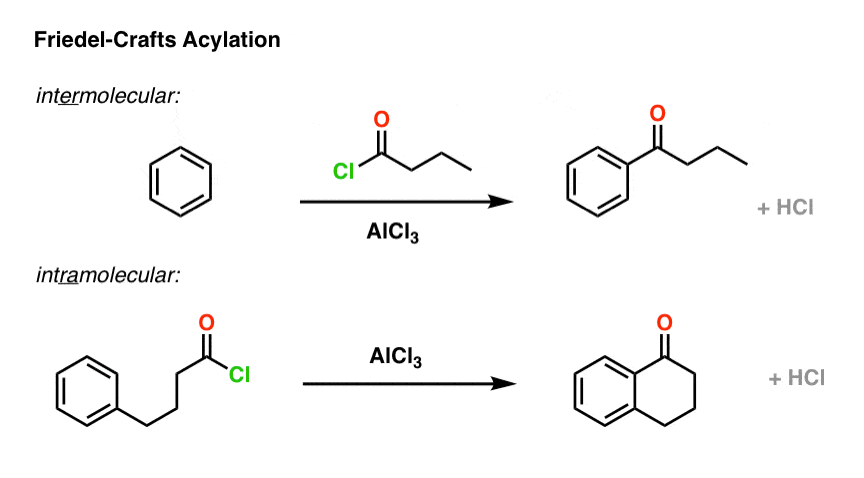
Again, I want you to verify that the bonds being formed and broken are exactly the same in each case. The only difference is that in the second case, the nucleophile and the electrophile are attached to each other through a tether.
One little wrinkle that you probably won’t see, but what the heck. We’re used to seeing acyl halides (and anhydrides) in the Friedel-Crafts, but one interesting thing to note about the intramolecular Friedel-Crafts acylation is that carboxylic acids can participate too. For example, treating this carboxylic acid with a strong acid such as H2SO4 results in an intramolecular Friedel-Crafts acylation:
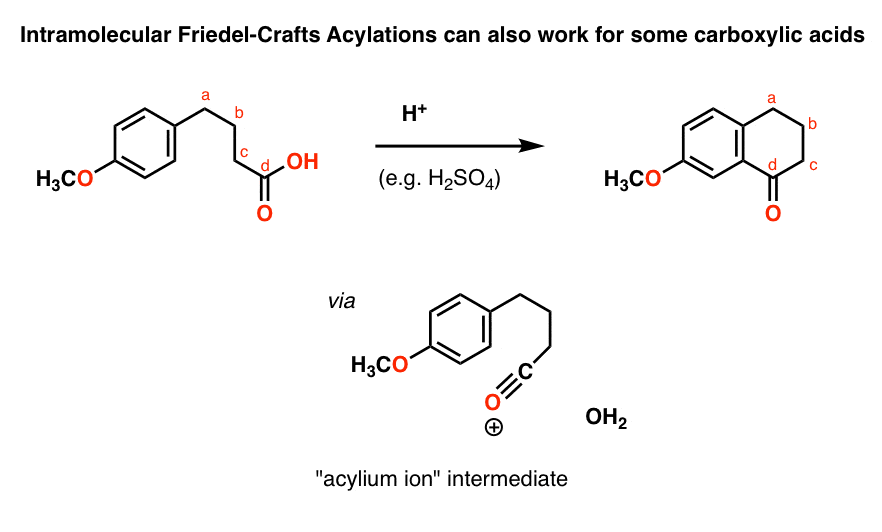
One reason why this works well for the intra- versus the intermolecular case is that the nucleophile is held so closely to the electrophile. This has the same effect as if the concentration of the electrophile was increased dramatically. You might see other examples where you can “get away with” using a poor nucleophile (or electrophile) in a given reaction if it’s done in an intramolecular fashion.
Here’s a challenge question for you. Can you draw the product of this sequence of Friedel-Crafts reactions?

4. Summary: Intramolecular Friedel-Crafts Reactions
No really groundbreaking new concepts here, but it’s always helpful to keep alert for intramolecular examples of reactions. This concept never goes away. You will see it again!
In our next post in this series we’ll cover a completely different class of substitution reactions on aromatic compounds that works well with electron-poor aromatic groups. It’s called Nucleophilic Aromatic Substitution.
Notes
Related Articles
Note 1. Rearrangement vs. ring closure. We’ve seen that primary alkyl halides can rearrange via hydride (and alkyl) shifts to give the “more stable” carbocation intermediates. So what happens when a primary alkyl halide is involved in an intramolecular Friedel-Crafts alkylation reaction? Does rearrangement happen first, or is ring closure faster?
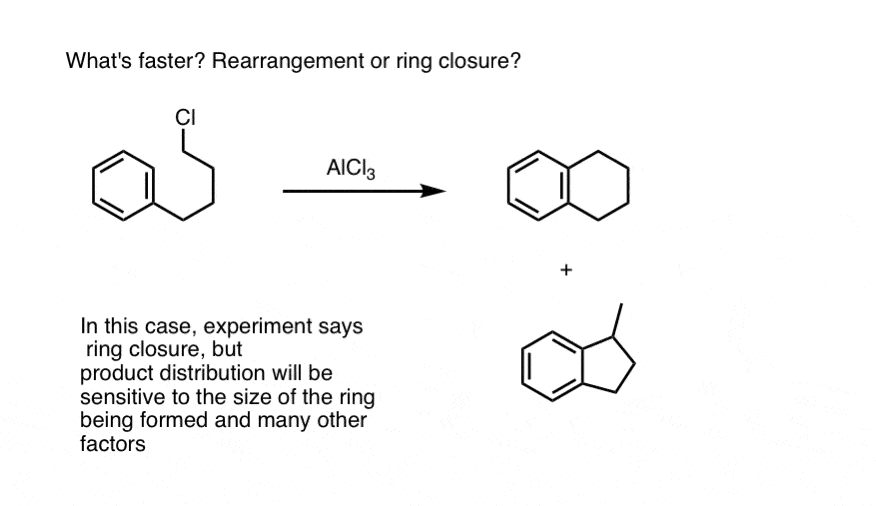
This is not the kind of question you can answer simply by thinking about it. When there are competing reaction rates, the only way to know for sure is through experiment.
This was studied, and the full paper on the study of rates of rearrangement versus ring closure is here. [J. Org. Chem, 1966, 31, 89]. Would indicate that closure to the 6-membered ring is faster than closure to the 5 membered ring in this case.


To see a plausible mechanism, hover here or click this link.
(Advanced) References and Further Reading
Friedel-Crafts acylation and alkylation can be intramolecular, and this is useful for the synthesis of bicyclic or polycyclic compounds.
Intramolecular alkylation:
Intramolecular F-C alkylations are most successful for the preparation of 6-membered rings, although 5- and 7-membered rings have also been closed in this manner. It is somewhat easier to form 6-membered than 5-membered rings in these reactions. 4-phenyl-1-butanol gives the cyclized tetralin in 50% yield in phosphoric acid, whereas 3-phenyl-1-butanol is mainly dehydrated to alkenes.
If a potential carbocation intermediate can undergo a hydride or alkyl shift (or Wagner-Meerwein rearrangement), this occurs in preference to ring closure of the 5-membered ring. This reflects a rather general tendency for 6 > 5,7 in ring closure by intramolecular Friedel-Crafts reactions.
- New Friedel—Crafts Chemistry. XVI.1 A Reconsideration of Cyclialkylation and Competing Reactions of Certain Phenylalkyl, Benzoylalkyl, and Acetylphenylalkyl Chlorides
Ali Ali Khalaf and Royston M. Roberts
The Journal of Organic Chemistry 1966, 31 (1), 89-95
DOI: 1021/jo01339a018 - New Friedel-Crafts chemistry. XIX. Cyclialkylations of some phenylalkanols
Ali A. Khalaf and Royston M. Roberts
The Journal of Organic Chemistry 1969, 34 (11), 3571-3574
DOI: 1021/jo01263a075 - Friedel-Crafts cyclialkylations of certain mono- and diphenyl-substituted alcohols and alkyl chlorides
Ali Ali Khalaf and Royston M. Roberts
The Journal of Organic Chemistry 1972, 37 (26), 4227-4235
DOI: 1021/jo00799a001 - Cyclization of 2-[N-(methylsulfonyl)anilino]acetaldehyde diethyl acetals to indoles. Evidence for stereoelectronic effects in intramolecular electrophilic aromatic substitution
Richard J. Sundberg and Joseph P. Laurino
The Journal of Organic Chemistry 1984, 49 (2), 249-254
DOI: 10.1021/jo00176a007
This paper has a section discussing the differences in the transition state geometries for 5- and 6- membered intramolecular ring closure. 5-membered transition states are significantly more strained, especially if it is assumed that the electrophilic carbon attacks from a direction perpendicular to the plane of the ring.Further examples of intramolecular Friedel-Crafts alkylations: - Experiments directed toward the total synthesis of terpenes. XVII. Development of methods for the synthesis of pentacyclic triterpenes based on a mechanistic interpretation of the stereochemical outcome of the Friedel-Crafts cyclialkylation reaction
Robert E. Ireland, Steven W. Baldwin, and Steven C. Welch
Journal of the American Chemical Society 1972, 94 (6), 2056-2066
DOI: 10.1021/ja00761a044
This is an example of a polycyclic ring system, where the product is a 3:1 mixture of b:a methyl isomers at the new ring junction, reflecting a preference for the orientation of the groups in the transition state. - A systematic study of benzyl cation initiated cyclization reactions
Steven R. Angle and Michael S. Louie
The Journal of Organic Chemistry 1991, 56 (8), 2853-2866
DOI: 10.1021/jo00008a049
This paper examines intramolecular F-C alkylation onto a benzylic position. 6-membered rings are formed more efficiently than 5- or 7-membered rings. - Enantiospecific synthesis of (+)-(R)-1-phenyl-3-methyl-1,2,4,5-tetrahydrobenz[d]azepine from (+)-(S)-N-methyl-1-phenyl ethanolamine (halostachine) via arene chromium tricarbonyl methodology
Steven J. Coote, Stephen G. Davies, David Middlemiss, Alan Naylor
Tetrahedron Lett. 1989, 30 (27), 3581-3588
DOI: 10.1016/S0040-4039(00)99447-4
The intramolecular F-C alkylations done with standard conditions (e.g. H2SO4/TFA or HBF4·OMe2) lead to racemic product, as expected. Chirality can be induced through an unusual (but advanced) methodology involving organometallics – reversibly forming an arene-Cr(CO)3 complex.Intramolecular acylation: - The Synthesis of 2-Hydroxy-17-equilenone
E. Bachmann and W. J. Horton
Journal of the American Chemical Society 1947, 69 (1), 58-61
DOI: 10.1021/ja01193a014
A classical reagent for intramolecular cyclization of phenalkyl carboxylic acids is PPA (polyphosphoric acid), which can be made by adding P2O5 and phosphoric acid. This is not used all that much anymore, since it is a pain to handle – very corrosive, and extremely viscous. - Methanesulfonic acid. A useful cyclizing acidic reagent
Alberto A. Leon, Guido Daub, and I. Robert Silverman
The Journal of Organic Chemistry 1984, 49 (23), 4544-4545
DOI: 10.1021/jo00197a047
MSA (methanesulfonic acid, CH3SO3H) is an alternative for PPA in F-C cyclization reactions. It is cheap, readily available, and is a easily handled liquid, comparable in acidity to PPA. - Spectroscopic and Other Properties of Large Ring Mono- and Dimeric Benzocyclanones Prepared by a High-dilution Friedel-Crafts Reaction
M. Schubert, W. A. Sweeney, and H. K. Latourette
Journal of the American Chemical Society 1954, 76 (21), 5462-5466
DOI: 10.1021/ja01650a060
While intramolecular F-C acylation is mainly used to close 5-, 6-, and 7-membered rings, even larger rings can be closed by high-dilution techniques. - Efficient synthesis of selected indenones
Brawner. Floyd and George Rodger. Allen
The Journal of Organic Chemistry 1970, 35 (8), 2647-2653
DOI: 10.1021/jo00833a036
Intramolecular F-C acylation can also be done with acyl chloride/AlCl3.Tandem reactions with both acylation and alkylation are also possible; these are termed cycli-acyalkylations. Unsaturated acids or lactones can be used. - α-TETRALONE
Cecil E. Olson, Alfred R. Bader, and G. Dana Johnson
Org. Synth. 1955, 35, 95
DOI: 10.15227/orgsyn.035.0095
The first procedure, submitted by A. R. Bader, uses a lactone to efficiently do a tandem F-C cycli-acylalkylation. A. R. Bader went on to found the Aldrich Chemical company, which made him extremely wealthy and forever changed the course of chemical research – chemists now do not have to spend their efforts resynthesizing common starting materials, as these are available off the shelf at high purities. - The scope of the Haworth synthesis
Israel Agranat and Yu-Shan Shih
Journal of Chemical Education 1976, 53 (8), 488
DOI: 10.1021/ed053p488
The first part of the Haworth synthesis involves F-C acylation with an anhydride, followed by intramolecular F-C alkylation after reducing the ketone.
00 General Chemistry Review
01 Bonding, Structure, and Resonance
- How Do We Know Methane (CH4) Is Tetrahedral?
- Hybrid Orbitals and Hybridization
- How To Determine Hybridization: A Shortcut
- Orbital Hybridization And Bond Strengths
- Sigma bonds come in six varieties: Pi bonds come in one
- A Key Skill: How to Calculate Formal Charge
- The Four Intermolecular Forces and How They Affect Boiling Points
- 3 Trends That Affect Boiling Points
- How To Use Electronegativity To Determine Electron Density (and why NOT to trust formal charge)
- Introduction to Resonance
- How To Use Curved Arrows To Interchange Resonance Forms
- Evaluating Resonance Forms (1) - The Rule of Least Charges
- How To Find The Best Resonance Structure By Applying Electronegativity
- Evaluating Resonance Structures With Negative Charges
- Evaluating Resonance Structures With Positive Charge
- Exploring Resonance: Pi-Donation
- Exploring Resonance: Pi-acceptors
- In Summary: Evaluating Resonance Structures
- Drawing Resonance Structures: 3 Common Mistakes To Avoid
- How to apply electronegativity and resonance to understand reactivity
- Bond Hybridization Practice
- Structure and Bonding Practice Quizzes
- Resonance Structures Practice
02 Acid Base Reactions
- Introduction to Acid-Base Reactions
- Acid Base Reactions In Organic Chemistry
- The Stronger The Acid, The Weaker The Conjugate Base
- Walkthrough of Acid-Base Reactions (3) - Acidity Trends
- Five Key Factors That Influence Acidity
- Acid-Base Reactions: Introducing Ka and pKa
- How to Use a pKa Table
- The pKa Table Is Your Friend
- A Handy Rule of Thumb for Acid-Base Reactions
- Acid Base Reactions Are Fast
- pKa Values Span 60 Orders Of Magnitude
- How Protonation and Deprotonation Affect Reactivity
- Acid Base Practice Problems
03 Alkanes and Nomenclature
- Meet the (Most Important) Functional Groups
- Condensed Formulas: Deciphering What the Brackets Mean
- Hidden Hydrogens, Hidden Lone Pairs, Hidden Counterions
- Don't Be Futyl, Learn The Butyls
- Primary, Secondary, Tertiary, Quaternary In Organic Chemistry
- Branching, and Its Affect On Melting and Boiling Points
- The Many, Many Ways of Drawing Butane
- Wedge And Dash Convention For Tetrahedral Carbon
- Common Mistakes in Organic Chemistry: Pentavalent Carbon
- Table of Functional Group Priorities for Nomenclature
- Summary Sheet - Alkane Nomenclature
- Organic Chemistry IUPAC Nomenclature Demystified With A Simple Puzzle Piece Approach
- Boiling Point Quizzes
- Organic Chemistry Nomenclature Quizzes
04 Conformations and Cycloalkanes
- Staggered vs Eclipsed Conformations of Ethane
- Conformational Isomers of Propane
- Newman Projection of Butane (and Gauche Conformation)
- Introduction to Cycloalkanes
- Geometric Isomers In Small Rings: Cis And Trans Cycloalkanes
- Calculation of Ring Strain In Cycloalkanes
- Cycloalkanes - Ring Strain In Cyclopropane And Cyclobutane
- Cyclohexane Conformations
- Cyclohexane Chair Conformation: An Aerial Tour
- How To Draw The Cyclohexane Chair Conformation
- The Cyclohexane Chair Flip
- The Cyclohexane Chair Flip - Energy Diagram
- Substituted Cyclohexanes - Axial vs Equatorial
- Ranking The Bulkiness Of Substituents On Cyclohexanes: "A-Values"
- Cyclohexane Chair Conformation Stability: Which One Is Lower Energy?
- Fused Rings - Cis-Decalin and Trans-Decalin
- Naming Bicyclic Compounds - Fused, Bridged, and Spiro
- Bredt's Rule (And Summary of Cycloalkanes)
- Newman Projection Practice
- Cycloalkanes Practice Problems
05 A Primer On Organic Reactions
- The Most Important Question To Ask When Learning a New Reaction
- Curved Arrows (for reactions)
- Nucleophiles and Electrophiles
- The Three Classes of Nucleophiles
- Nucleophilicity vs. Basicity
- What Makes A Good Nucleophile?
- What Makes A Good Leaving Group?
- 3 Factors That Stabilize Carbocations
- Equilibrium and Energy Relationships
- 7 Factors that stabilize negative charge in organic chemistry
- 7 Factors That Stabilize Positive Charge in Organic Chemistry
- What's a Transition State?
- Hammond's Postulate
- Learning Organic Chemistry Reactions: A Checklist (PDF)
- Introduction to Oxidative Cleavage Reactions
06 Free Radical Reactions
- Bond Dissociation Energies = Homolytic Cleavage
- Free Radical Reactions
- 3 Factors That Stabilize Free Radicals
- What Factors Destabilize Free Radicals?
- Bond Strengths And Radical Stability
- Free Radical Initiation: Why Is "Light" Or "Heat" Required?
- Initiation, Propagation, Termination
- Monochlorination Products Of Propane, Pentane, And Other Alkanes
- Selectivity In Free Radical Reactions
- Selectivity in Free Radical Reactions: Bromination vs. Chlorination
- Halogenation At Tiffany's
- Allylic Bromination
- Bonus Topic: Allylic Rearrangements
- In Summary: Free Radicals
- Synthesis (2) - Reactions of Alkanes
- Free Radicals Practice Quizzes
07 Stereochemistry and Chirality
- Types of Isomers: Constitutional Isomers, Stereoisomers, Enantiomers, and Diastereomers
- How To Draw The Enantiomer Of A Chiral Molecule
- How To Draw A Bond Rotation
- Introduction to Assigning (R) and (S): The Cahn-Ingold-Prelog Rules
- Assigning Cahn-Ingold-Prelog (CIP) Priorities (2) - The Method of Dots
- Enantiomers vs Diastereomers vs The Same? Two Methods For Solving Problems
- Assigning R/S To Newman Projections (And Converting Newman To Line Diagrams)
- How To Determine R and S Configurations On A Fischer Projection
- The Meso Trap
- Optical Rotation, Optical Activity, and Specific Rotation
- Optical Purity and Enantiomeric Excess
- What's a Racemic Mixture?
- Chiral Allenes And Chiral Axes
- Stereochemistry Practice Problems and Quizzes
08 Substitution Reactions
- Nucleophilic Substitution Reactions - Introduction
- Two Types of Nucleophilic Substitution Reactions
- The SN2 Mechanism
- Why the SN2 Reaction Is Powerful
- The SN1 Mechanism
- The Conjugate Acid Is A Better Leaving Group
- Comparing the SN1 and SN2 Reactions
- Polar Protic? Polar Aprotic? Nonpolar? All About Solvents
- Steric Hindrance is Like a Fat Goalie
- Common Blind Spot: Intramolecular Reactions
- Substitution Practice - SN1
- Substitution Practice - SN2
09 Elimination Reactions
- Elimination Reactions (1): Introduction And The Key Pattern
- Elimination Reactions (2): The Zaitsev Rule
- Elimination Reactions Are Favored By Heat
- Two Elimination Reaction Patterns
- The E1 Reaction
- The E2 Mechanism
- E1 vs E2: Comparing the E1 and E2 Reactions
- Antiperiplanar Relationships: The E2 Reaction and Cyclohexane Rings
- Bulky Bases in Elimination Reactions
- Comparing the E1 vs SN1 Reactions
- Elimination (E1) Reactions With Rearrangements
- E1cB - Elimination (Unimolecular) Conjugate Base
- Elimination (E1) Practice Problems And Solutions
- Elimination (E2) Practice Problems and Solutions
10 Rearrangements
11 SN1/SN2/E1/E2 Decision
- Identifying Where Substitution and Elimination Reactions Happen
- Deciding SN1/SN2/E1/E2 (1) - The Substrate
- Deciding SN1/SN2/E1/E2 (2) - The Nucleophile/Base
- SN1 vs E1 and SN2 vs E2 : The Temperature
- Deciding SN1/SN2/E1/E2 - The Solvent
- Wrapup: The Key Factors For Determining SN1/SN2/E1/E2
- Alkyl Halide Reaction Map And Summary
- SN1 SN2 E1 E2 Practice Problems
12 Alkene Reactions
- E and Z Notation For Alkenes (+ Cis/Trans)
- Alkene Stability
- Alkene Addition Reactions: "Regioselectivity" and "Stereoselectivity" (Syn/Anti)
- Stereoselective and Stereospecific Reactions
- Hydrohalogenation of Alkenes and Markovnikov's Rule
- Hydration of Alkenes With Aqueous Acid
- Rearrangements in Alkene Addition Reactions
- Halogenation of Alkenes and Halohydrin Formation
- Oxymercuration Demercuration of Alkenes
- Hydroboration Oxidation of Alkenes
- m-CPBA (meta-chloroperoxybenzoic acid)
- OsO4 (Osmium Tetroxide) for Dihydroxylation of Alkenes
- Palladium on Carbon (Pd/C) for Catalytic Hydrogenation of Alkenes
- Cyclopropanation of Alkenes
- A Fourth Alkene Addition Pattern - Free Radical Addition
- Alkene Reactions: Ozonolysis
- Summary: Three Key Families Of Alkene Reaction Mechanisms
- Synthesis (4) - Alkene Reaction Map, Including Alkyl Halide Reactions
- Alkene Reactions Practice Problems
13 Alkyne Reactions
- Acetylides from Alkynes, And Substitution Reactions of Acetylides
- Partial Reduction of Alkynes With Lindlar's Catalyst
- Partial Reduction of Alkynes With Na/NH3 To Obtain Trans Alkenes
- Alkyne Hydroboration With "R2BH"
- Hydration and Oxymercuration of Alkynes
- Hydrohalogenation of Alkynes
- Alkyne Halogenation: Bromination, Chlorination, and Iodination of Alkynes
- Alkyne Reactions - The "Concerted" Pathway
- Alkenes To Alkynes Via Halogenation And Elimination Reactions
- Alkynes Are A Blank Canvas
- Synthesis (5) - Reactions of Alkynes
- Alkyne Reactions Practice Problems With Answers
14 Alcohols, Epoxides and Ethers
- Alcohols - Nomenclature and Properties
- Alcohols Can Act As Acids Or Bases (And Why It Matters)
- Alcohols - Acidity and Basicity
- The Williamson Ether Synthesis
- Ethers From Alkenes, Tertiary Alkyl Halides and Alkoxymercuration
- Alcohols To Ethers via Acid Catalysis
- Cleavage Of Ethers With Acid
- Epoxides - The Outlier Of The Ether Family
- Opening of Epoxides With Acid
- Epoxide Ring Opening With Base
- Making Alkyl Halides From Alcohols
- Tosylates And Mesylates
- PBr3 and SOCl2
- Elimination Reactions of Alcohols
- Elimination of Alcohols To Alkenes With POCl3
- Alcohol Oxidation: "Strong" and "Weak" Oxidants
- Demystifying The Mechanisms of Alcohol Oxidations
- Protecting Groups For Alcohols
- Thiols And Thioethers
- Calculating the oxidation state of a carbon
- Oxidation and Reduction in Organic Chemistry
- Oxidation Ladders
- SOCl2 Mechanism For Alcohols To Alkyl Halides: SN2 versus SNi
- Alcohol Reactions Roadmap (PDF)
- Alcohol Reaction Practice Problems
- Epoxide Reaction Quizzes
- Oxidation and Reduction Practice Quizzes
15 Organometallics
- What's An Organometallic?
- Formation of Grignard and Organolithium Reagents
- Organometallics Are Strong Bases
- Reactions of Grignard Reagents
- Protecting Groups In Grignard Reactions
- Synthesis Problems Involving Grignard Reagents
- Grignard Reactions And Synthesis (2)
- Organocuprates (Gilman Reagents): How They're Made
- Gilman Reagents (Organocuprates): What They're Used For
- The Heck, Suzuki, and Olefin Metathesis Reactions (And Why They Don't Belong In Most Introductory Organic Chemistry Courses)
- Reaction Map: Reactions of Organometallics
- Grignard Practice Problems
16 Spectroscopy
- Degrees of Unsaturation (or IHD, Index of Hydrogen Deficiency)
- Conjugation And Color (+ How Bleach Works)
- Introduction To UV-Vis Spectroscopy
- UV-Vis Spectroscopy: Absorbance of Carbonyls
- UV-Vis Spectroscopy: Practice Questions
- Bond Vibrations, Infrared Spectroscopy, and the "Ball and Spring" Model
- Infrared Spectroscopy: A Quick Primer On Interpreting Spectra
- IR Spectroscopy: 4 Practice Problems
- 1H NMR: How Many Signals?
- Homotopic, Enantiotopic, Diastereotopic
- Diastereotopic Protons in 1H NMR Spectroscopy: Examples
- 13-C NMR - How Many Signals
- Liquid Gold: Pheromones In Doe Urine
- Natural Product Isolation (1) - Extraction
- Natural Product Isolation (2) - Purification Techniques, An Overview
- Structure Determination Case Study: Deer Tarsal Gland Pheromone
17 Dienes and MO Theory
- What To Expect In Organic Chemistry 2
- Are these molecules conjugated?
- Conjugation And Resonance In Organic Chemistry
- Bonding And Antibonding Pi Orbitals
- Molecular Orbitals of The Allyl Cation, Allyl Radical, and Allyl Anion
- Pi Molecular Orbitals of Butadiene
- Reactions of Dienes: 1,2 and 1,4 Addition
- Thermodynamic and Kinetic Products
- More On 1,2 and 1,4 Additions To Dienes
- s-cis and s-trans
- The Diels-Alder Reaction
- Cyclic Dienes and Dienophiles in the Diels-Alder Reaction
- Stereochemistry of the Diels-Alder Reaction
- Exo vs Endo Products In The Diels Alder: How To Tell Them Apart
- HOMO and LUMO In the Diels Alder Reaction
- Why Are Endo vs Exo Products Favored in the Diels-Alder Reaction?
- Diels-Alder Reaction: Kinetic and Thermodynamic Control
- The Retro Diels-Alder Reaction
- The Intramolecular Diels Alder Reaction
- Regiochemistry In The Diels-Alder Reaction
- The Cope and Claisen Rearrangements
- Electrocyclic Reactions
- Electrocyclic Ring Opening And Closure (2) - Six (or Eight) Pi Electrons
- Diels Alder Practice Problems
- Molecular Orbital Theory Practice
18 Aromaticity
- Introduction To Aromaticity
- Rules For Aromaticity
- Huckel's Rule: What Does 4n+2 Mean?
- Aromatic, Non-Aromatic, or Antiaromatic? Some Practice Problems
- Antiaromatic Compounds and Antiaromaticity
- The Pi Molecular Orbitals of Benzene
- The Pi Molecular Orbitals of Cyclobutadiene
- Frost Circles
- Aromaticity Practice Quizzes
19 Reactions of Aromatic Molecules
- Electrophilic Aromatic Substitution: Introduction
- Activating and Deactivating Groups In Electrophilic Aromatic Substitution
- Electrophilic Aromatic Substitution - The Mechanism
- Ortho-, Para- and Meta- Directors in Electrophilic Aromatic Substitution
- Understanding Ortho, Para, and Meta Directors
- Why are halogens ortho- para- directors?
- Disubstituted Benzenes: The Strongest Electron-Donor "Wins"
- Electrophilic Aromatic Substitutions (1) - Halogenation of Benzene
- Electrophilic Aromatic Substitutions (2) - Nitration and Sulfonation
- EAS Reactions (3) - Friedel-Crafts Acylation and Friedel-Crafts Alkylation
- Intramolecular Friedel-Crafts Reactions
- Nucleophilic Aromatic Substitution (NAS)
- Nucleophilic Aromatic Substitution (2) - The Benzyne Mechanism
- Reactions on the "Benzylic" Carbon: Bromination And Oxidation
- The Wolff-Kishner, Clemmensen, And Other Carbonyl Reductions
- More Reactions on the Aromatic Sidechain: Reduction of Nitro Groups and the Baeyer Villiger
- Aromatic Synthesis (1) - "Order Of Operations"
- Synthesis of Benzene Derivatives (2) - Polarity Reversal
- Aromatic Synthesis (3) - Sulfonyl Blocking Groups
- Birch Reduction
- Synthesis (7): Reaction Map of Benzene and Related Aromatic Compounds
- Aromatic Reactions and Synthesis Practice
- Electrophilic Aromatic Substitution Practice Problems
20 Aldehydes and Ketones
- What's The Alpha Carbon In Carbonyl Compounds?
- Nucleophilic Addition To Carbonyls
- Aldehydes and Ketones: 14 Reactions With The Same Mechanism
- Sodium Borohydride (NaBH4) Reduction of Aldehydes and Ketones
- Grignard Reagents For Addition To Aldehydes and Ketones
- Wittig Reaction
- Hydrates, Hemiacetals, and Acetals
- Imines - Properties, Formation, Reactions, and Mechanisms
- All About Enamines
- Breaking Down Carbonyl Reaction Mechanisms: Reactions of Anionic Nucleophiles (Part 2)
- Aldehydes Ketones Reaction Practice
21 Carboxylic Acid Derivatives
- Nucleophilic Acyl Substitution (With Negatively Charged Nucleophiles)
- Addition-Elimination Mechanisms With Neutral Nucleophiles (Including Acid Catalysis)
- Basic Hydrolysis of Esters - Saponification
- Transesterification
- Proton Transfer
- Fischer Esterification - Carboxylic Acid to Ester Under Acidic Conditions
- Lithium Aluminum Hydride (LiAlH4) For Reduction of Carboxylic Acid Derivatives
- LiAlH[Ot-Bu]3 For The Reduction of Acid Halides To Aldehydes
- Di-isobutyl Aluminum Hydride (DIBAL) For The Partial Reduction of Esters and Nitriles
- Amide Hydrolysis
- Thionyl Chloride (SOCl2)
- Diazomethane (CH2N2)
- Carbonyl Chemistry: Learn Six Mechanisms For the Price Of One
- Making Music With Mechanisms (PADPED)
- Carboxylic Acid Derivatives Practice Questions
22 Enols and Enolates
- Keto-Enol Tautomerism
- Enolates - Formation, Stability, and Simple Reactions
- Kinetic Versus Thermodynamic Enolates
- Aldol Addition and Condensation Reactions
- Reactions of Enols - Acid-Catalyzed Aldol, Halogenation, and Mannich Reactions
- Claisen Condensation and Dieckmann Condensation
- Decarboxylation
- The Malonic Ester and Acetoacetic Ester Synthesis
- The Michael Addition Reaction and Conjugate Addition
- The Robinson Annulation
- Haloform Reaction
- The Hell–Volhard–Zelinsky Reaction
- Enols and Enolates Practice Quizzes
23 Amines
- The Amide Functional Group: Properties, Synthesis, and Nomenclature
- Basicity of Amines And pKaH
- 5 Key Basicity Trends of Amines
- The Mesomeric Effect And Aromatic Amines
- Nucleophilicity of Amines
- Alkylation of Amines (Sucks!)
- Reductive Amination
- The Gabriel Synthesis
- Some Reactions of Azides
- The Hofmann Elimination
- The Hofmann and Curtius Rearrangements
- The Cope Elimination
- Protecting Groups for Amines - Carbamates
- The Strecker Synthesis of Amino Acids
- Introduction to Peptide Synthesis
- Reactions of Diazonium Salts: Sandmeyer and Related Reactions
- Amine Practice Questions
24 Carbohydrates
- D and L Notation For Sugars
- Pyranoses and Furanoses: Ring-Chain Tautomerism In Sugars
- What is Mutarotation?
- Reducing Sugars
- The Big Damn Post Of Carbohydrate-Related Chemistry Definitions
- The Haworth Projection
- Converting a Fischer Projection To A Haworth (And Vice Versa)
- Reactions of Sugars: Glycosylation and Protection
- The Ruff Degradation and Kiliani-Fischer Synthesis
- Isoelectric Points of Amino Acids (and How To Calculate Them)
- Carbohydrates Practice
- Amino Acid Quizzes
25 Fun and Miscellaneous
- A Gallery of Some Interesting Molecules From Nature
- Screw Organic Chemistry, I'm Just Going To Write About Cats
- On Cats, Part 1: Conformations and Configurations
- On Cats, Part 2: Cat Line Diagrams
- On Cats, Part 4: Enantiocats
- On Cats, Part 6: Stereocenters
- Organic Chemistry Is Shit
- The Organic Chemistry Behind "The Pill"
- Maybe they should call them, "Formal Wins" ?
- Why Do Organic Chemists Use Kilocalories?
- The Principle of Least Effort
- Organic Chemistry GIFS - Resonance Forms
- Reproducibility In Organic Chemistry
- What Holds The Nucleus Together?
- How Reactions Are Like Music
- Organic Chemistry and the New MCAT
26 Organic Chemistry Tips and Tricks
- Common Mistakes: Formal Charges Can Mislead
- Partial Charges Give Clues About Electron Flow
- Draw The Ugly Version First
- Organic Chemistry Study Tips: Learn the Trends
- The 8 Types of Arrows In Organic Chemistry, Explained
- Top 10 Skills To Master Before An Organic Chemistry 2 Final
- Common Mistakes with Carbonyls: Carboxylic Acids... Are Acids!
- Planning Organic Synthesis With "Reaction Maps"
- Alkene Addition Pattern #1: The "Carbocation Pathway"
- Alkene Addition Pattern #2: The "Three-Membered Ring" Pathway
- Alkene Addition Pattern #3: The "Concerted" Pathway
- Number Your Carbons!
- The 4 Major Classes of Reactions in Org 1
- How (and why) electrons flow
- Grossman's Rule
- Three Exam Tips
- A 3-Step Method For Thinking Through Synthesis Problems
- Putting It Together
- Putting Diels-Alder Products in Perspective
- The Ups and Downs of Cyclohexanes
- The Most Annoying Exceptions in Org 1 (Part 1)
- The Most Annoying Exceptions in Org 1 (Part 2)
- The Marriage May Be Bad, But the Divorce Still Costs Money
- 9 Nomenclature Conventions To Know
- Nucleophile attacks Electrophile
27 Case Studies of Successful O-Chem Students
- Success Stories: How Corina Got The The "Hard" Professor - And Got An A+ Anyway
- How Helena Aced Organic Chemistry
- From a "Drop" To B+ in Org 2 – How A Hard Working Student Turned It Around
- How Serge Aced Organic Chemistry
- Success Stories: How Zach Aced Organic Chemistry 1
- Success Stories: How Kari Went From C– to B+
- How Esther Bounced Back From a "C" To Get A's In Organic Chemistry 1 And 2
- How Tyrell Got The Highest Grade In Her Organic Chemistry Course
- This Is Why Students Use Flashcards
- Success Stories: How Stu Aced Organic Chemistry
- How John Pulled Up His Organic Chemistry Exam Grades
- Success Stories: How Nathan Aced Organic Chemistry (Without It Taking Over His Life)
- How Chris Aced Org 1 and Org 2
- Interview: How Jay Got an A+ In Organic Chemistry
- How to Do Well in Organic Chemistry: One Student's Advice
- "America's Top TA" Shares His Secrets For Teaching O-Chem
- "Organic Chemistry Is Like..." - A Few Metaphors
- How To Do Well In Organic Chemistry: Advice From A Tutor
- Guest post: "I went from being afraid of tests to actually looking forward to them".
I wondered that the activated lactone by Alcl3 in answer #2 is which part in lactone reacted with Alcl3? Is the oxygen in lactone ring or the oxygen in carbonyl group? How should I choose from two of them?
Just like acyl chloride is the chloride react with the Alcl3
Good question. The carbonyl oxygen is activated by AlCl3. This sets up the carboxylate to act as a leaving group when the ring attacks at the sp3 hybridized carbon. That’s the first Friedel-Crafts. The second Friedel Crafts is an acylation reaction where O-AlCl3(-) is the leaving group.
I’m most of the way through the tetralone mechanism, but I can’t figure out the final dissociation of the aluminium complex. I had the bridging oxygen in the ester complex initially with the aluminium trichloride first, break the ring and the acylium formation. F-C acylation and rearomatization like normal, but here is where I’m confused. The aluminium centre has a negative charge, and the oxygen is no longer positively charged, so if the C-O bond breaks to alkylate, I have a doubly negative aluminium species. Where did I go wrong?
Thanks!
Right. Try the alkylation first – your leaving group will be RCO2Alcl3, which will then be well primed for FC acylation
Sir please tell the mechanism when acid anhydride react with 2 eq of alcl3 with benzene
Answer #2??? I need an explanation!!!
It’s a sequence of friedel-crafts acylation and then friedel-crafts alkylation. First step: AlCl3 reacts with the oxygen of the lactone, resulting in formation of the acylium ion which is attacked by the aromatic ring. Now you have an oxygen coordinated to AlCl3 (a good Lewis acid). The AlCl3 converts the oxygen into a good leaving group. So what can happen next is attack of the aromatic ring at the carbon bearing the oxygen, resulting in formation of a new six-membered ring.
In the example given for intra mole ular freidal crafts reaction ,acylium
Cation attacks meta to OCH3 group which is ortho para directing .It is not the major product.
You are proposing that a seven membered ring would form containing a trans double bond. That is not going to be a stable molecule.
The article is very nice. I would like to know source or reference for the particular example where you intramolecular acylation of carboxylic acids as I have some confusion as to why the ether has not been hydrolysed.
The reference is linked at the bottom, but it’s Organic Syntheses, Coll. Vol. 4, p.898 (1963); Vol. 35, p.95 (1955).
What happens with the alcohol is that it eventually coordinates to AlCl3 which activates it towards attack by the aromatic ring, and it departs as a leaving group.
But an R group is an ortho para director, and the major product is para, so why isn’t it close and connect to the para position of the aromatic ring?
The answer is that the para product would be very strained. The carbonyl can’t reach the para position in a way that leads to non-strained bond lengths and bond angles. If you are unsure about this I invite you to try to build a model!
In practice problem #1 it appears that you changed the reactant from a seven carbon chain in the practice problem to a six carbon chain in the answer key.
Shoot. Thank you Kirk, will fix.
Fixed, finally.
I wonder if there would be any takers to propose the mechanism for the tetralone formation via the above mentioned Friedel-Crafts :) I used to put that one on an exam for like 3 or 4 years. Students didn’t appreciate the challenge…
Yeah, that would definitely not win any fans.